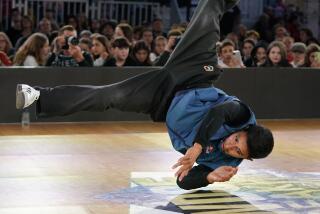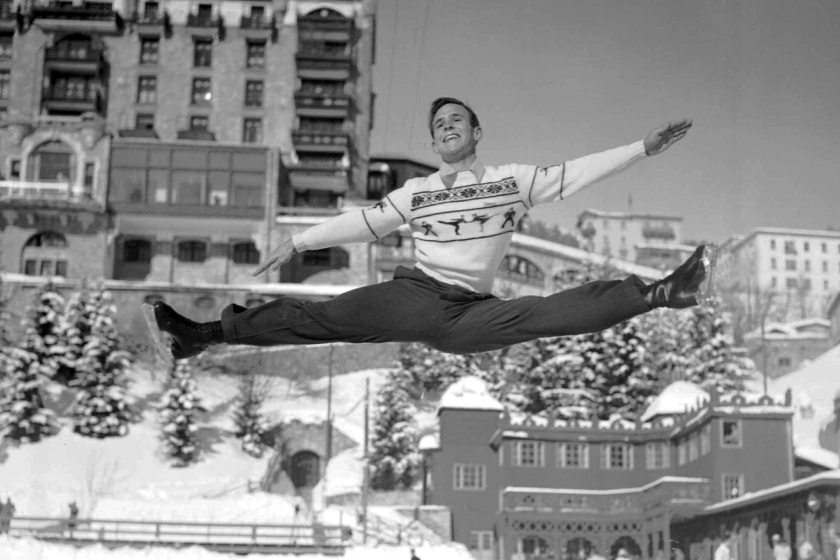He’s Still Reaching for the Sky
- Share via
When Mike Tully first showed up in a pole vault pit, the skivvies-and-spiked-shoes set wasn’t too impressed.
“What’s the matter, kid, surf’s not up?” they sneered. Or, “The ocean’s that way.”
The problem was, Tully didn’t look like a vaulter. He had Hang Ten written all over him.
First of all, there was that shaggy blond hair. Then, there were the gray eyes, the collar-ad good looks, the dimples. A refugee from “Beach Blanket Bingo.”
“Gidget ain’t here,” they wanted to warn him.
Pole vaulting, you see, is no day at the beach. First of all, it’s very dangerous. You can’t drown, but you sure can break your back. Several vaulters have done exactly that. At least one has died.
The crossbar is up there nearly 20 feet above the ground these days, and if you land any place except the pit, the effect is a little like being pushed out a second-story window onto the pavement.
They thought Mike would start to yearn for an ocean to break his fall about the third time he missed the foam rubber on his descent.
Then, too, pole vaulting is hard work, maybe the hardest work in track and field this side of the decathlon. You have to be able to run, lift, jump and heave. The projectile is yourself. You need strength, speed, balance and nerve.
It’s a pressure event because, even though you get three tries, misses at low altitudes count against you, unlike in other field events. It’s a cat-and-mouse game, too. The better practitioners try to psych you out.
For all these reasons, track-and-fielders thought that Tully would be back on the sand, looking for the perfect wave by his second jump.
That was 10 years ago. Since then, Mike Tully has won the silver medal in the 1984 Olympic Games, has periodically set and held the world record in the vault, has been over 19 feet so many times he’s lost count and has probably cleared the crossbar 10,000 times.
The pole vault used to be as uniquely an American event as the Fourth of July. We owned it in fee simple. We never lost it in an Olympics. It didn’t matter whether the implement was bamboo, steel, aluminum or fiberglass, we went higher, quicker than any other nationality.
This went on without interruption until the Munich Olympics of 1972, when a task force of international track federation officials, spurred by the East Germans, marched into Bob Seagren’s rooms at the Olympic Village and confiscated all his poles. He had to jump with borrowed equipment the next day.
An East German won the event, which was probably the idea, Seagren was second and the U.S., which had won in 16 straight Olympics, has not won since.
The U.S. lost at Montreal in 1976 when the favorite, Dave Roberts, passed on a height that would have given him the win. By the time he re-entered the competition it had begun to rain. He missed three times and finished third.
The Carter boycott in 1980 left vaulting in such disarray that it almost did drive Tully back to the beach.
“I didn’t care anymore,” recalls Tully. “I didn’t have any motivation. I slept on the White House lawn while they explained it to us.
“But I never did retire,” he adds. “I stopped vaulting for 18 months but I never said I was through.”
To no one’s surprise, Tully made some television movies and, when the ’84 Olympics came round, most people thought he would be going by limousine, a starlet on his arm. Instead, he went on the team bus.
Pole vaulting is a grueling sport in which you lug a 7-pound, 17-foot implement clumsily by one end down a 125-foot runway. Then you plant the pole and try to bend it in half to catapult yourself into the air, like a Navy fighter leaving an aircraft carrier.
With the Russians boycotting, Tully, surprisingly, had the second-best mark in the world going into the ’84 Olympics but his beach-boy, Hollywood image, as usual, lowered expectations. Still, in the long, wearing competition--4 hours and 10 minutes--Tully won the silver medal.
He eliminated one Frenchman, Thierry Vigneron, who had a better mark for the year than he, but fell to another Frenchman, Pierre Quinon, in a battle of tactics.
Tully is taking dead aim at the Seoul Olympics and to that end will be planting his pole in the Sunkist Invitational indoor meet at the Sports Arena, Friday, Jan. 22. Ten years after everyone had been sure he would be back in a bikini, riding a board, Tully is the most tenacious character in the pit.
“I’ve never had a job but I have a house and a car and a steady income,” he reminds. “As to what happened to American pole vaulting, I really can’t tell you except to tell you that I have always had to negotiate for my own poles, find a runway and a foam rubber landing.
“When I go for a workout, I have to circle around to find a parking space. I have to locate my own gym to work out. In other countries, these things are worked out for you. All you have to do is jump.”
At Seoul, the Russians’ mighty world record-holder, Sergei Bubka, will be on hand, as will the doughty Poles. But Olympic medals do not always go to the record setters. They sometimes go to guys who look out of place on dry land.
Before the ’88 competition is over, a lot of pole vaulters, upper and lower case P, may wish the dire predictions of 10 years ago would have come true and that Mike Tully would have given up his poles and headed back to sea.
More to Read
Go beyond the scoreboard
Get the latest on L.A.'s teams in the daily Sports Report newsletter.
You may occasionally receive promotional content from the Los Angeles Times.






